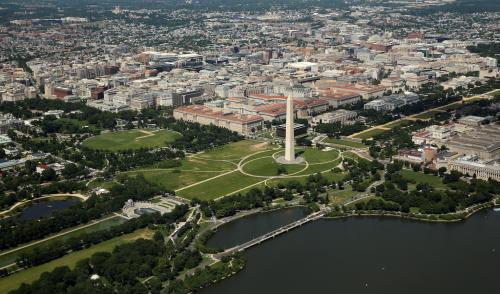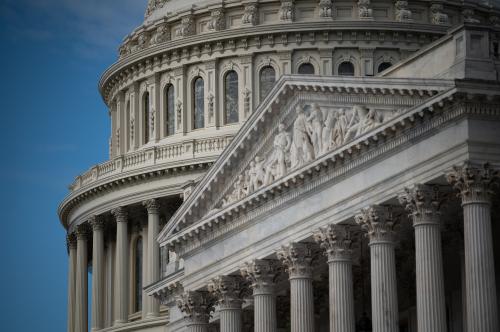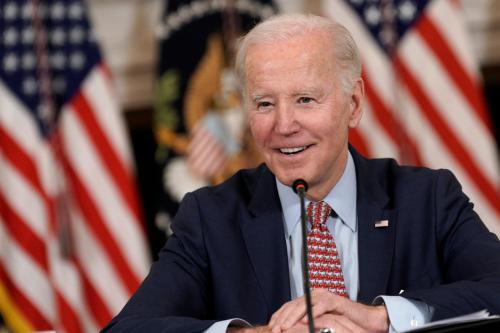Even as recent polling shows strong public support for President Biden’s $5 trillion “spend-whatever-it-takes-without-delay” agenda, Americans remain divided on the future of government. Interviewed last February, 51% of Americans said they favored a bigger government that provides more services, 43% favored a smaller government that provides fewer services.[1]
These respondents also split on calls for government reform. As this update to my October FixGov series shows, public demand for very major government reform remains near a twenty-year high, while trust in the federal government remains at historic lows. Trust may yet rebound with the number of vaccinations and a steady hand, but Biden still needs a plan for fixing government fast, especially given the odds of breakdowns along the way.
This short report will revisit the case for government reform by answering seven questions:
- Is the demand for reform still high?
- Do the parties share any common ground?
- What kind of reforms do Americans want?
- Will the surge in breakdowns continue?
- Will Congress act on government reform?
- Can Biden win small-government support?
- What should Biden fix first?
- Is the demand for reform still high?
As Figure 1 shows, public demand for reform hit 53% at the start of Barack Obama’s second term and remains at or near the high-water mark. As of last February, 55% of Americans said the federal government still needed very major reform, a third said the federal government was “basically sound” and needed only some reform, and just a tenth said it did not need much reform at all. See Figure 1 for the trend line.
Figure 1
The demand for very major reform has generally held steady over the past two decades, albeit with a seven-point decline over the past five years and a slight rise in the number who say the federal government does not need much change at all. Demand is unlikely to fall further until the number of Americans who say government is almost always wasteful and inefficient, does only a fair or poor job running its programs, and is run by few big interests who are looking out for themselves also drops.
- Do the parties share any common ground on reform?
Party identification plays a key role in shaping the demand for reform, as does party control of the White House. As the trend lines suggest, Republicans were more likely than Democrats to favor very major reform when Bill Clinton and Obama were in office and while Democrats were more likely than Republicans to favor very major reform when President Trump was running for a second term.
This “party-in-power” effect helps explain pre-and post-election variations in demand before and after the 2020 election. Between August and February, for example, the percentage of Democrats who favored very major reform fell from 70% to 30%, while the number of Republicans who favored major reform rose from 44% to 60%.
Party identification clearly influences demand, but so does the economy, social media, scandal, today’s racialization of electoral politics. Asked in August why “many Black people cannot get ahead these days,” 76% of respondents who favored very major government reform said racial discrimination was the main reason why many Black people can’t get ahead these days, compared to just 53% who said Black people who can’t get ahead today are mostly responsible for their situation.[2]
- What kind of reforms do Americans want?
My ongoing analysis of reform demand focuses on movement among four groups of respondents: (1) dismantlers who favor a combination of very major reform and a smaller government, (2) rebuilders who favor major reform and a bigger government, (3) expanders who favor only some reform and a bigger government, and (4) streamliners who favor only some reform and a smaller government.
Table 1: The Four Philosophies of Reform
| The federal government needs very major reform | The federal government is basically sound and needs only some reform | |
| Would rather have a smaller government providing fewer services | Dismantlers | Streamliners |
| Would rather have a bigger government providing more services | Rebuilders | Expanders |
The four reform philosophies have shifted over time with campaigns and crises. As Figure 2 shows, the expanders held a 43% plurality among all respondents as the economy boomed in 1997, but faded as the number of dismantlers surged toward the end of the Obama administration and the Great Recession. In turn, the number of rebuilders grew steadily over the years in response to the dismantlers before dropping slightly in 2021 as the number of expanders increased in what appears to be a response to Biden’s “whatever it takes” spending package.
Figure 2
Viewed across party lines, the percentage of Republican dismantlers increased from 32 to 44% between August 2020 and February 2021, while the percentage of Republican streamliners fell from 37 to 20%. In turn, the percentage of Democratic rebuilders dropped from 51 to 42% during the period, while the percentage of Democratic expanders rose from 18 to 27%, again in a likely response to Biden’s agenda. Although these shifts suggest another bitter campaign if Trump runs again in 2024, the changes also signal greater clarity between Republicans as champions of dismantling and Democrats as a force for expanding.
These divisions affect more than electoral sentiment. Asked last February whether they would like to see a son or daughter pursue a career in government, Americans were evenly divided between “yes” and “no.” However, the divisions were much deeper across the four reform philosophies where 62% of the rebuilders and expanders said “yes,” while 68% of the dismantlers and 53% of the streamliners said “no.”
Younger Americans were sharply divided on government careers, too, suggesting potential recruiting challenges ahead when the baby boomers retire. Fifty-two percent of the 18-29-year-olds interviewed would recommend a career in government to a son or daughter, but the rebuilders (69%) and expanders (59%) were more like to say “yes” than the dismantlers (32%) and streamliners (50%). My research on public-service careers more generally suggests that younger Americans are not saying “show me the money” when asked about government service, but “show me the impact.” Even the rebuilders may wonder whether they can have impact in the blizzard of breakdowns, insults, sluggish application systems, and polarization.
- Will the surge in government breakdowns continue?
Biden took the oath of office in the wake of Trump’s record-setting surge in government breakdowns. Despite his promises to buy things for less money, run government like a business, and streamline the hierarchy, Trump left office with the single-year and single-term number of breakdowns dating back to Ronald Reagan’s second term and fell just one breakdown short of matching Obama’s two-term record in his one-term presidency.[3]
Biden has no reason to believe that the recent breakdown surge ended with Trump’s defeat. As Figure 3 shows, the number of government failures has been rising since the 1980s. Absent a rigorous reform agenda and quick congressional action, Biden faces significant risks ahead. Indeed, even as the House was voting to pass Biden’s relief package, Biden’s press secretary was fielding Washington Post questions about potential implementation failures and New York Times questions about unaccompanied children at the border.
Figure 3
Biden knows breakdowns often come in surges. He was Vice President when the number of breakdowns increased from just eight in Obama’s first term to 20 in his second. He was also fully engaged in addressing the VA waiting-list scandal, the anthrax and avian flu accidents, the Ebola crisis, and the first “Children’s Crossing.” Biden’s déjà vu will continue until he launches his reform program.
Unfortunately, Biden may find the reform cupboard empty. It has been twenty-five years since the last agency-by-agency analysis of the government organization chart, forty-five since the Supreme Court voided the president’s authority to send Congress fast-track, up-or-down reorganization plans, and more than seventy since the last blue-ribbon reorganization campaign came to a close. Biden needs an Office of Management and Budget that understands management, an Office of Personnel Management that cares about people, inspectors general who are free to report, and a to-do list of repairs.
- Will Congress act on government reform?
Congress is certain to pass new laws in coming years to fix broken agencies, rebuild the civil service, strengthen whistleblower protections, and build firewalls against future presidential excess. However, the question is not whether it will pursue reform, but which tides of reform it will embrace. Will Congress pursue scientific management and its tight rules, launch a war on waste and inefficiency to trim the budget, increase public access to information, and/or liberate government employees from needless paperwork?
Recent history suggests that Congress will give the edge to scientific management and its commitment to administrative rules. Scientific management already accounts for 40% of the 210 major reform statutes that Congress passed between the end of World War II and 2021 and fits the demand for tighter organization charts and clear chains of command. At the same time, Congress will also pay attention to more sunshine in government through freedom of information and ethics reform.
Recent history also suggests that Congress will favor small-scale action over large. As my October 2020 , the Trump administration produced the fewest number of reforms of any administration since the end of World War II, just one of which can be considered a large-scale effort. The embedded parochialism and interest group resistance are so great today that tinkering may be the best a deeply divided Congress can produce.
Nevertheless, the opportunity for a small number of large-scale reforms remains. Although the Clinton administration’s number of large-scale reforms was relatively low, Vice President Al Gore’s reinventing government team produced more legislative impact than any administration dating back to Truman.
- Can Biden win small-government support?
New York Times columnist Paul Krugman may be right that Biden is the big spender America wants, but Biden still has to face Americans who favored a smaller government that delivers fewer services last February. The question is how Biden can win small-government support.
Trump may have given Biden the answer by creating the second largest federal workforce in recent history. As Figure 4 shows, the number of full-time-equivalent federal jobs increased from 8.7 million in October 2017 to 10.9 million four years later. Although civil service, postal service, and active-duty military headcounts held steady, Trump’s stealth jobs program increased the number of contract- and grant-funded employees to within 40,000 jobs of Obama’s Great-Recession total. Meanwhile, Trump’s defense and transportation spending increased the ratio of contract and grant employees from 2.4 per civil servant in 2017 to 3.5 in 2020.[4]
Figure 4
Biden’s $5 trillion pandemic and infrastructure agenda may yet drive contractor and grantee employment higher, but he should be able to cull enough savings from Trump’s defense budget to push the true size of government down to Ronald Reagan’s 1984 mark. Meanwhile, Biden could rebuild Obama’s 2009 insourcing process to reverse the recent hollowing out of the federal workforce.
- What should Biden fix first?
Tempted though Congress might be with tinkering, Biden should focus broadly on the federal government’s rising vulnerability to failure. The breakdown curve has accelerated with the steady erosion of government capacity, the failure to modernize aging bureaucracies, and the deafening “quiet crisis” of student disinterest in government careers that former Federal Reserve Board chairman, Paul A. Volcker fought to remedy for the last thirty years of his life.
Biden’s first challenge is to attack the bloated hierarchies that Trump left behind. Much as Trump complained about all the useless “people over people over people” he would have to appoint, he never met a new layer he could not embrace. Biden should show him just how flat the federal bureaucracy can go by winnowing the 83 layers at the very top of government, while resisting the temptation to fill the 4,000 presidential appointments open for occupancy when Biden arrived.
With bloat on pause, Biden should ask former Vice President Al Gore to lead a blue-ribbon reform campaign modeled on Harry Truman’s blue-ribbon reorganization commissions. A Gore commission could bring his reinventing agenda back into focus at a moment of great need while giving Biden a chance to make the for temporary reorganization authority. Gore has the gravitas to lead the effort, an army of alums ready to go back to work, and the judgment to finish the job he was meant to do.
[1] These survey results come from questions fielded by SSRS on its weekly omnibus survey platform and were funded by the author. The July 28-August 2 random-sample cellphone and landline telephone survey collected the opinions of 1,006 randomly selected respondents, while the February 2-7, 2021 survey collected the opinions of 1,010 randomly selected respondents on cellphone and landline also. The margins of error in both surveys were in the +/- 3-4 percent range at a 95 percent confidence level.
[2] For an analysis of recent trends in racialization, see Adam M. Enders and Jamil S. Scott, “The Increasing Racialization of American Electoral Politics, 1988-2016, American Politics Research, February 27, 2018, 47(2), 275-3030.
[3] News interest is defined in the following list as the percentage of respondents paying a great deal or fair amount of attention to a story in the news.
| Breakdowns on Donald Trump’s watch, 2017-2021 | ||
| Year | News Interest | |
| 1. Russian campaign meddling | 2017 | 59% |
| 2. Transition missteps | 2017 | 64% |
| 3. The opioid/fentanyl crisis | 2017 | 57% |
| 4. White House staff turmoil | 2017 | 60% |
| 5. Sluggish response to Hurricanes Irma and Maria | 2017 | 62% |
| 6. Appointee turnover, vacancies, misconduct, and purges | 2017 | 60% |
| 7. FBI failure to investigate Parkland High School tips | 2018 | 57% |
| 8. Family-Separation policy implementation failures and overcrowding | 2018 | 67% |
| 9. Record-setting federal government shutdown | 2018 | 80% |
| 10. Delays and mismanaged care at the Department of Veterans Affairs | 2019 | 59% |
| 11. Ukraine quid pro quo | 2019 | 64% |
| 12. Boeing 737 MAX 8 regulatory delegations | 2019 | 62% |
| 13. Uncertainty during the Syria withdrawal | 2019 | 43% |
| 14. Chaos during the first COVID-19 spike | 2020 | 89% |
| 15. Policy failures during the COVID-19 economic collapse | 2020 | 70% |
| 16. Continued COVID-19 medical supply shortages | 2020 | 62% |
| 17. George Floyd murder | 2020 | 84% |
| 18. Afghanistan bounty killings | 2020 | 60% |
| 19. Postal Service crash | 2020 | 49% |
| 20. IRS stimulus checks to dead people | 2020 | 30% |
| 21. Continued barriers to COVID-19 testing | 2020 | 71% |
| 22. White House COVID-19 superspreader | 2020 | 69% |
| 23. Biden transition delays | 2020 | 62% |
| 24. Third COVID-19 Spike | 2020 | 66% |
| 25. SolarWinds Hack | 2020 | 70% |
| 26. Vaccination rollout delays | 2021 | 70% |
| 27. Capitol Hill insurrection | 2021 | 88% |
[4] The civil-service head-counts used in this report come from the Office of Management and Budget’s Historical Tables, the active duty military head-counts come from the Defense Manpower Data Center, the number of postal service employees comes from USPS.com, and the estimated number of contract and grant employees from estimates derived from the Federal Assistance Awards Data System the Federal Procurement Data System-Next Generation. The estimates of contract and grant spending relies on the U.S. Bureau of Economic Analysis regional input/output model of the economy and its RIMS II multipliers to convert federal contract and grant spending into estimated full-time-equivalent jobs.
The estimates used in this analysis were generated by Nation Analytics in early October 2020 based on all spending as of September 31, 2020. These early estimates were updated in February 2021 to include all Fiscal Year 2020 invoices paid after the first October 2020 sweep. and updated with all spending with updates in February 2021. This end-of-fiscal-year surge produced $43 billion in additional contract invoicing and an estimated 450,000 contract-generated jobs. I am grateful to Nick Taborek for his work on this estimating process. This analysis only includes employees who are paid directly through federal contracts and grants or indirectly through sub-contracts and sub-grants, while excluding the induced employment created through spending by these jobs.
See the following table for the totals:
| 1984 | 1990 | 1993 | 1996 | 1999 | 2002 | 2005 | 2010 | 2015 | 2017 | 2020 est. | 2020 final | |
| Civil service | 2.08 | 2.17 | 2.14 | 1.89 | 1.78 | 1.76 | 1.83 | 2.13 | 2.04 | 2.06 | 2.21 | 2.21 |
| Active-duty military | 2.14 | 2.04 | 1.71 | 1.47 | 1.39 | 1.41 | 1.52 | 1.38 | 1.32 | 1.33 | 1.36 | 1.36 |
| Postal Service | 0.67 | 0.76 | 0.69 | 0.76 | 0.80 | 0.75 | 0.71 | 0.58 | 0.49 | 0.51 | 0.50 | 0.50 |
| Contract-funded | 3.67 | 3.43 | 3.25 | 3.04 | 2.40 | 2.79 | 3.88 | 4.85 | 3.70 | 3.63 | 5.03 | 5.32 |
| Grant-funded | 1.23 | 1.35 | 1.34 | 1.35 | 1.42 | 1.24 | 1.58 | 2.34 | 1.58 | 1.19 | 1.82 | 2.31 |
| Total | 9.79 | 9.76 | 9.13 | 8.52 | 7.78 | 7.95 | 9.51 | 11.29 | 9.13 | 8.72 | 10.92 | 11.70 |
The Brookings Institution is committed to quality, independence, and impact.
We are supported by a diverse array of funders. In line with our values and policies, each Brookings publication represents the sole views of its author(s).








Commentary
What Americans still want from reform: An April 2021 update
April 15, 2021